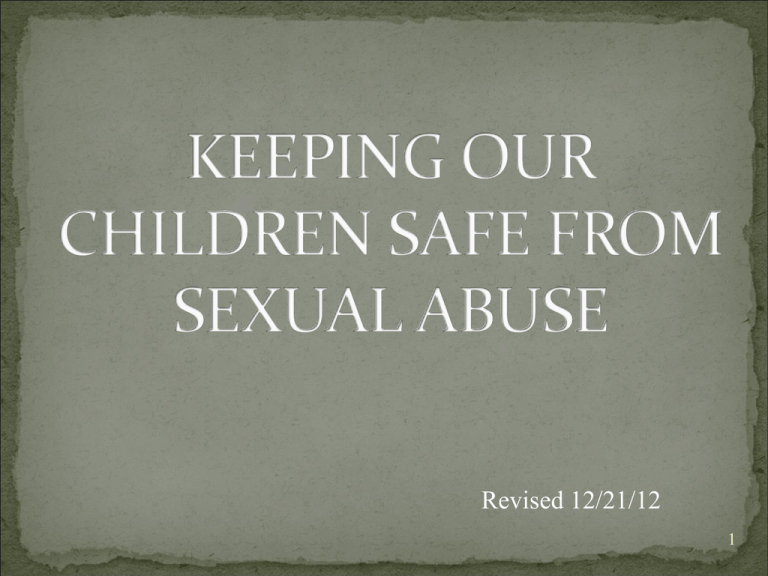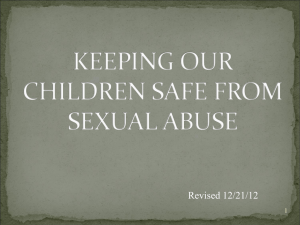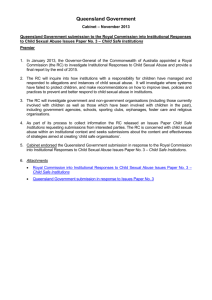Jenna`s Law
advertisement

Revised 12/21/12 1 Also called “Jenna’s Law,” named after Jenna Quinn, a survivor of sexual abuse This law became effective June 19, 2009 2 This bill requires districts to adopt and implement a policy addressing sexual abuse of children, and to increase staff, student and parent awareness about this issue. 3 1 in 4 girls and 1 in 6 boys will be sexually abused by the age of 18 More than 90% of juvenile sexual abuse victims know their perpetrator in some way Sexual abuse accounts for 9.2% of all reports for maltreatment of children 4 The perpetrator is usually someone known by the victim More than 3 million reports of child maltreatment are received each year— approximately 6 reports per minute 5 …. is not new. Districts have worked with students, families, law enforcement and community resources for many years. However, we want to heighten the awareness of this issue. 6 Changes in behavior—scared, anxious, depressed, withdrawn, aggressive Returning to earlier behaviors—infantile behavior, thumb sucking, fear of the dark, loss of acquired language, bed wetting Fear of going home or fear of a familiar person or place Changes in eating—could result in weight gain or weight loss Changes in sleeping—nightmares, difficulty falling asleep, tired, fatigued 7 Changes in school performance and attendance— difficulty concentrating, excessive absences Lack of personal care or hygiene—may appear uncared for, have body odor, be dirty, lack sufficient clothing for the weather Risk-taking behaviors—drugs, alcohol, weapons Inappropriate sexual behavior—overly sexualized behavior or explicit sexual language, symptoms of genital infection Unexplained injuries—burns, bruises in the shape of objects 8 Child may receive phone calls, emails or text messages from someone the parents do not know Child may have a cell phone, money or gifts the parent did not give the child Hostility/mood swings/social isolation from friends 9 Some children may show ALL or NONE of the signs above. Trust your instincts. Suspicion of abuse is enough of a reason to take action. 10 These signs may also be symptoms of other problems, so be careful not to jump to conclusions. Are there several of these symptoms? Is there opportunity? Do not hesitate to use professional community resources to figure out what is going on. 11 Communication is key! Listen, believe, and trust what your child tells you Education—teach your child healthy values about sexuality Help your child learn to set boundaries Help younger children understand “good touch” vs. “bad touch” Give your child specific information about where on the body your child should not be touched or touch 12 Encourage your child to tell you if someone is making him/her feel uncomfortable Give your child permission to say “no” to an adult if uncomfortable – even adults your child knows Emphasize the need to tell and not keep secrets! Let your child know he/she will not be in trouble Tell your child NEVER to meet someone in person that he/she met online unless you are there Get to know your child’s friends and the homes in which your child plays. 13 Be wary of older children or adults who want to spend a lot of time alone with your child Trust your intuition—if you feel something is not right in your child’s relationships, act on it Have “safety talks” with your child several times a year Computer usage—Use an Internet Service Provider (ISP) that offers screening for obscenity and pornography 14 Remain calm; do not overreact Let your child tell the story in his/her own words – do not give your child the words. This can damage the case Believe your child Praise your child for telling you Reassure your child that you will protect him/her Get competent professional counseling Immediately call law enforcement and/or CPS 15 If the child tells you what has happened, call law enforcement and/or CPS Let the child use his/her own words; do not ask leading questions Do not appear shocked or have a strong reaction Reassure the child that this is not his/her fault Let the child know you believe him/her Depending on who the perpetrator is, go with the child to talk to the parents. 16 Remain calm when speaking to the child Ask the child if anyone has touched his/her body in an uncomfortable way Keep your eyes and ears open Consider seeking help from your pediatrician or a mental health provider If the child has made an outcry to you, your job is to report the outcry, not to investigate the outcry 17 •71% of teens have profiles online •64% post pictures or videos online •75% own cell phones •69% of teens have their own computer 18 •95% of parents don’t recognize the lingo kids use to let people know their parents are watching • 89% of sexual solicitations are made in either chat rooms or Instant Messages •20% of children aged 10-17 have been solicited sexually online (one out of five) •67% of teenagers say they know how to hide what they do online from parents 19 •Is everywhere •Is good – and bad •Is constantly changing •Is here to stay •The internet is a valuable tool that all should use, enjoy and feel comfortable with 20 PARENTS SHOULD •Make their expectations clear to their child •Talk about values •Talk about what is personal information •Talk about respect– for themselves and others •Learn not to overreact if their child comes to them for help 21 •NEVER sharing their password •Information that is considered personal information •Not communicating with someone on the computer whom they do not know •Letting you know if something happens to make them feel uncomfortable •Never meeting someone personally that they met online 22 •Facebook and Twitter are the two most popular •Remind your children whatever they post can be copied and can then show up other places •What you post can often be tracked •Keep your accounts set to private – and only let in friends you actually know 23 •Come from all walks of life •May pose online as someone who is the child’s own age •Often focus on the child’s vulnerabilities to “groom” the child (give gifts, free babysitting, play video games with child, give rides, strike up relationships with parents) •Work/volunteer with programs involving children 24 •Do not reveal too much information (even photos can do this) •Do not exaggerate your age or lie about who you are Do not accept “friends” you do not know personally •Do not respond to offensive or dangerous email, chat or other communication 25 •Insist on knowing the friends their child socializes with •Talk frequently with their child about who the child’s online friends are •Have their child show them what the child does online •Explore safeguarding programs their Internet Service Provider (ISP) may offer 26 1-800-252-5400 27 1-800-4-A-CHILD 1-800-422-4453 28 •Legislature of the State of Texas •National Center on Domestic and Sexual Violence •Childhelp •U.S. Department of Health and Human Services •Center for Disease Control and Prevention •ChildSafe •Pandora’s Aquarium •Save our Kids •Child Welfare Information Gateway 29 •National Child Traumatic Stress Network •Online Safety site •Pew Internet and American Life Project •Top Ten Reviews •Massachusetts Children’s Trust Fund •eBizMBA Rank •Minnesota Department of Corrections •FBI •Boys Town 30











